Dec 4, 2024
Products
Accelerating the Boom in AI Chips! Component Parts for Semiconductor Manufacturing Equipment
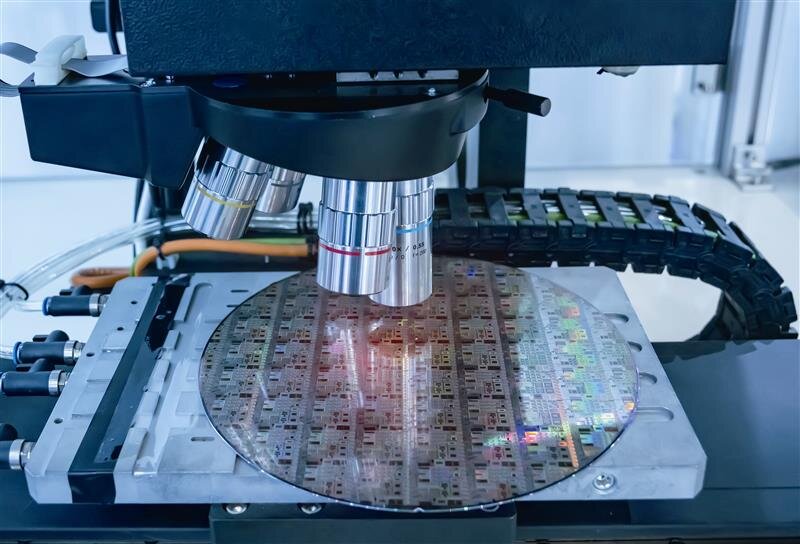
Digital transformation (DX) technology has developed rapidly in the last few years. This can be seen across a variety of fields in the adoption of generative AI, the dissemination of cloud computing, and the development of self-driving technology as well as closer to home in the form of digital appliances that can connect to your smartphone. All of these advances rely on semiconductors, and the industry that creates them is currently developing new manufacturing processes for the purpose of imbuing these components with even greater performance capabilities. In this article, we’ll take a look at linear motion guides that are frequently used in semiconductor manufacturing equipment and highlight which of these is best-suited to meeting each kind of required specification.
From Miniaturization to Particle Suppression: Requirements Unique to Semiconductor Manufacturing
Developing and producing high-performance semiconductor parts requires manufacturing equipment capable of supporting further component miniaturization and integration with high accuracy and fast cycle times. Likewise, linear motion guides, which are a critical factor for both the running accuracy and the positioning accuracy of manufacturing equipment, must also provide high accuracy and high-speed performance. In addition to this, they must also be appropriate for clean room environments, which serve to enhance semiconductor quality and reliability by performing the crucial role of suppressing contamination by particles produced in the manufacturing process.
LM Guide Models that Combine Uniform Motion, Running Accuracy, and Positioning Accuracy
In order to support miniaturization and high-density integration for semiconductors, manufacturing equipment must provide running accuracy, positioning accuracy, and uniformity of motion. Processing equipment also needs to be highly rigid to reduce displacement generated by reaction forces. The Super-Low Waving Caged Ball LM Guide Model SPR/SPS brings all of these factors together in one place.
Developed with the goal of attaining accuracy on par with that of static pressure guides, the Model SPR/SPS was first adopted for use in high-accuracy machine tools before making inroads into the semiconductor industry. When we talk about running accuracy, super-high accuracy on the nanometer scale is prevented by a phenomenon called waving. Waving refers to positional displacement of the table to which a guide is mounted that is caused by changes to the relative positions of blocks and the rolling elements they contain due to the rolling of those elements as the block moves back and forth.
The Model SPR/SPS generates considerably lower waving values than general linear motion rolling guides thanks to its small-diameter balls, eight rows of raceways, and longer blocks. For uniform motion, it provides a speed variance rate of ±0.04% for a single-axis table using a two-rail, four-block configuration and driven by a cored linear motor at a speed of 10 mm/s. As for positioning accuracy, the Model SPR/SPS has been shown capable of accurately following a 1 nm step command when tested for following performance with a minute-step drive. The model isn’t lacking in rigidity either, exhibiting superior performance in that metric in isolated rigidity tests compared to existing roller guides that use rollers as their rolling element.
While this super-low waving LM Guide exhibits superior performance across a multitude of metrics, its dimensions (especially its width) are larger than those of a typical LM Guide. This would require those who are developing new machine models based on old ones to revisit the design of areas where these guides are used. In response to the challenge this presents, THK has followed the Model SPR/SPS with the development of an LM Guide that offers the same super-low waving performance in addition to ISO-compliant dimensions (Model: SPH). The Model SPH has shorter blocks than the Model SPR/SPS, but it has been shown to produce almost identical waving values, positioning it well to have a growing presence in the market for high-accuracy parts in the future.
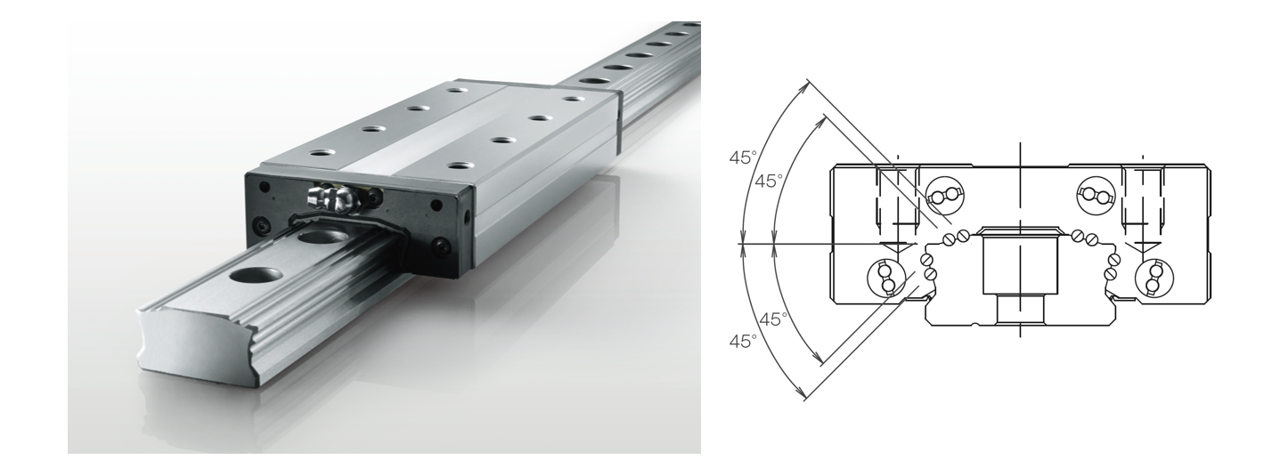
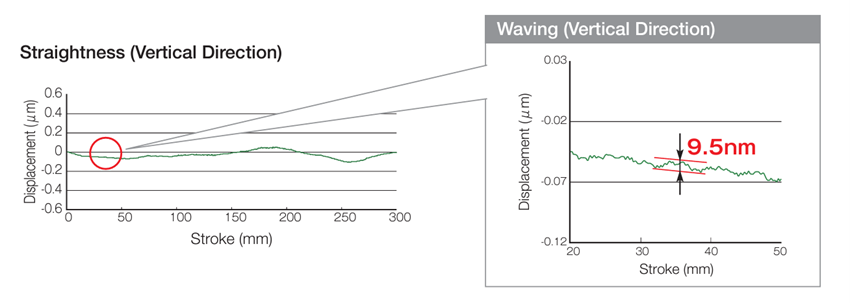
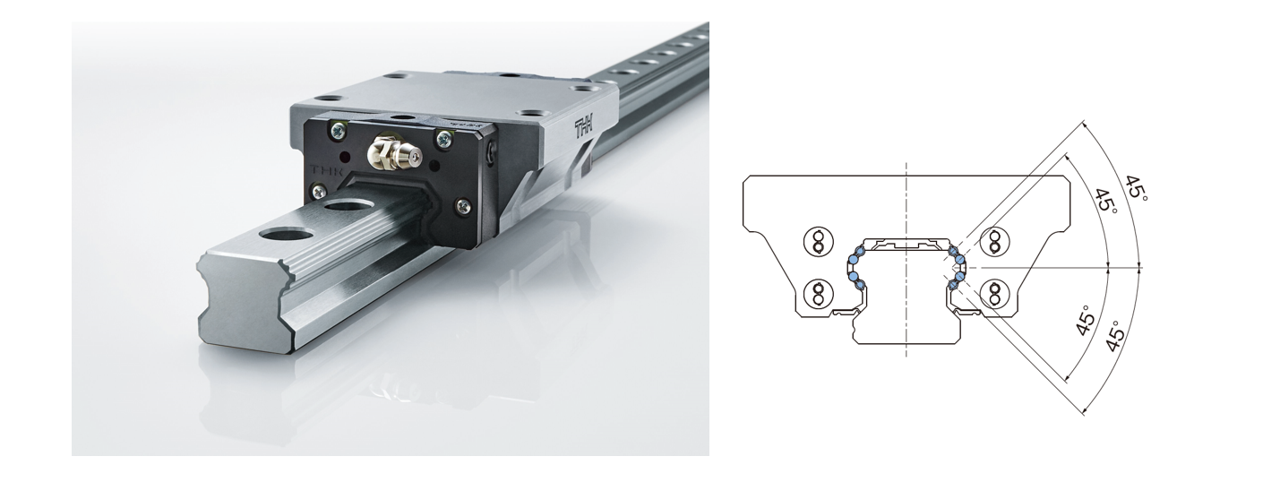
Waving Evaluation
| Legend | Model | Max. waving amplitude | Avg. waving amplitude |
|---|---|---|---|
| Existing product | 0.0634μm | 0.0505μm | |
| SPH25 | 0.0120μm | 0.0088μm |
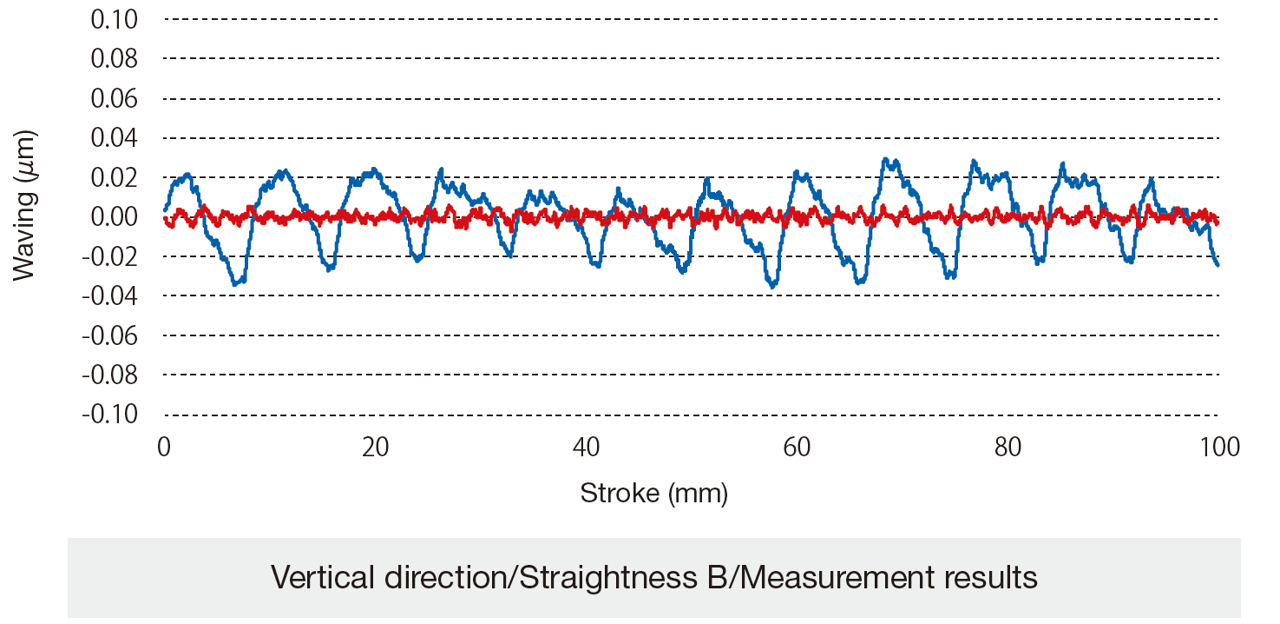
Improving Chips Per Hour (CPH) with Smaller, Lighter Machine Parts
Making semiconductor chips smaller allows for a larger number of them to be mounted on a printed board, which in turn enhances the computing power of that board. There is thus a need to increase the CPH, or chips per hour, of the machines that mount these small parts, meaning that they must mount more of them in a shorter period of time. Toward this end, the device that picks up the chips with suction, called the head, must move at high speeds. This, in turn, requires that the moving elements of the machine be made lighter. The linear motion rolling guides incorporated in these moving elements, then, have to be compact and lightweight while providing high-speed performance, high rigidity, and a long service life.
In order to address all of these demands, THK developed the Miniature Roller Type LM Guide Model HRG. While the smallest rail width offered for conventional roller guides is 15 mm, the HRG lineup includes rails that are 8 mm, 10 mm, and 12 mm wide. It is one of the smallest and lightest roller guides available worldwide, and it also boasts five times the service life and twice the rigidity of ball type guides of the same size.
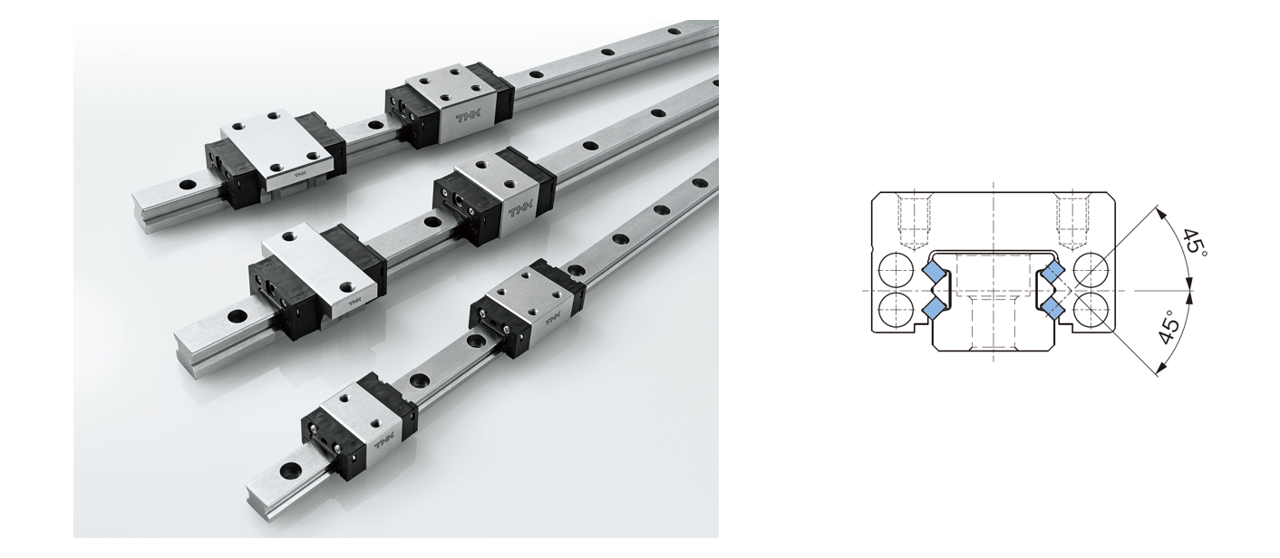
Despite being small, the head of a chip mounting machine houses a number of mechanisms that raise and lower the shaft. These make it possible for the head to grab many small semiconductor chips with suction in a short period of time. Highly rigid LM Guide units are required to address the vibrations generated by the high-acceleration/deceleration drive systems used by these mechanisms. One such product, the Miniature Ball Spline Model LT-X, was designed to make the outer diameter of the nut as small as possible specifically for this application. With an optimized ball circulation design, it has a nut with an outer diameter up to 10% smaller than that of a conventional Model LT. The smaller outer diameter of the nut makes it possible to incorporate multiple ball splines inside a small area.
And now, we even have a new addition to the Model LT-X lineup—this time with an even smaller shaft diameter of ∅3. By making the head of chip mounting machines even more compact, this new product will further contribute to high-density integration for semiconductor chips. Its smoother ball circulation also reduces fluctuations in sliding resistance.

High-Speed Performance to Improve Equipment Utilization and Servo Control
Two examples of machines that require linear motion guides with high-speed performance are die bonders and flip chip bonders. These machines need fast cycle times for improved productivity, durability in the face of repetitive motion for increased equipment utilization, and guide components with low sliding resistance for improved servo control. The Rapid-Acceleration and Low-Sliding Resistance Miniature LM Guide (Model: AHR) was developed precisely to meet these needs.
It is highly durable even at speeds as high as 5 m/s and under acceleration/deceleration as high as 30 G, and it provides lower sliding resistance than conventional miniature guides. Also, because its dimensions are interchangeable with those of conventional miniature guides, it can easily replace those you might already have installed on your equipment.
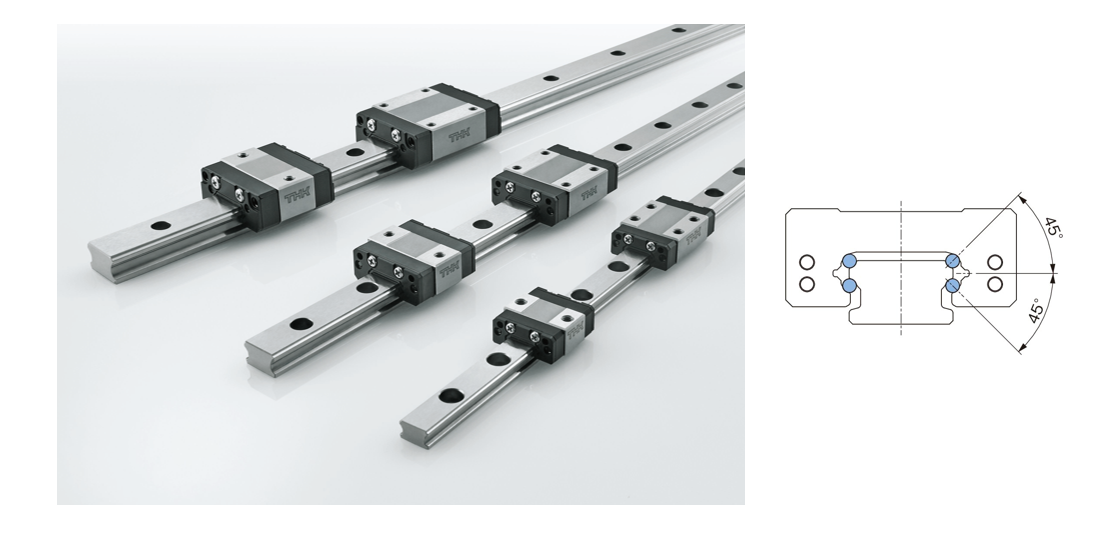
Other Specifications Required for Semiconductor Manufacturing
Next, let’s take a look at some of the other special specifications demanded by the semiconductor manufacturing process.
1. Corrosion resistance for film deposition and washing processes
The film deposition and washing processes of semiconductor manufacturing require linear motion guides that are resistant to corrosion by the various chemical agents used in each. Heat-treated high-carbon steel is used for general linear motion rolling guides to imbue them with high rigidity and longer service life. The need for corrosion resistance, however, presents an additional challenge. This is usually addressed by treating the surfaces of blocks and rails that are to be installed where chemical agents are used. The highly corrosion-resistant LM Guide Model HSR-M2, however, uses a rail made of highly corrosion-resistant austenitic stainless steel SUS304 with blocks and balls made of SUS431, the martensitic stainless steel with the highest corrosion resistance. These two materials provide greater corrosion resistance than the conventional SUS304 material.

2. Nonmagnetic properties for electron-beam lithography machines
Some semiconductor manufacturing processes require linear motion guides that can be used in environments where magnetism proves problematic, such as in electron-beam lithography machines. Non-magnetic materials are required, for instance, in machines that process the kind of cutting-edge semiconductors that have circuits a mere 2 nm wide. These minuscule circuits are drawn by an electron beam in a piece of equipment called a mask writer. If any of the machine’s peripheral components are magnetized, the electron beam will become skewed, making it impossible to write these circuits with the necessary precision.
Thus, these components must be made of non-magnetic materials. In order to meet the demand for components that are non-magnetic and have low magnetic permeability, THK developed a high-performance, non-magnetic, and extremely corrosion-resistant material in the form of the special alloy THK-NM1. This material, which boasts superior non-magnetic properties (including a relative magnetic permeability below 1.005), high hardness suited to use with bearings, and high corrosion resistance, can be used for LM Guide units, ball screws, ball splines, and even cross-roller rings. While hard ceramic materials are used as a non-magnetic material in some situations, this special alloy makes it possible to apply a preload by creating the ideal amount of elastic deformation on ball contact surfaces. Additionally, of all special materials appropriate for use in bearings, this alloy is particularly resistant to magnetism and capable of providing smooth motion without any rattling. We believe that it will continue to play a role in the next-generation of manufacturing processes.
We’ve also added the Low-Magnetic Permeability LM Guide Model HSR-M3 to our standard product lineup to respond to an even larger range of the market's needs for products with low magnetic permeability. The global standard dimensions and four-way equal load performance provided by the Model HSR make it an even easier choice for use in your equipment. And, in addition to guaranteeing a relative magnetic permeability of 1.02 or less, the Model HSR-M3 also provides high wear resistance at a hardness of 40 HRC or greater, which is made possible by age hardening.
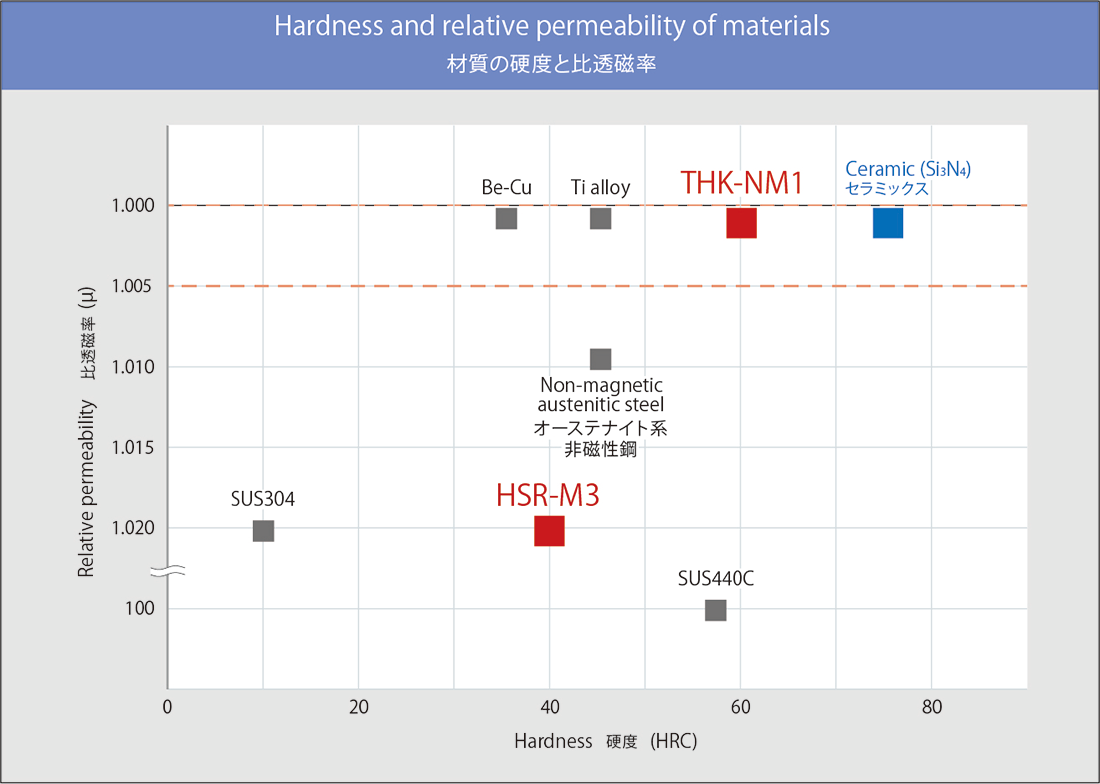
3. Low dust generation for clean room environments
Next, let’s look at greases that are suitable for use in a clean room environment. Proper lubrication is necessary to prevent seizure and abnormal wear from metal-to-metal contact between the raceway and rolling elements of a linear motion guide. In a clean environment, however, dust generated by grease spatter can stick to workpieces and cause defects to occur. This makes low dust-generating grease a must. Below, we’ll introduce the three types of clean grease developed by THK.
・AFF Grease for reduced fretting
Composed of a high-grade synthetic oil and lithium-based consistency enhancer, AFF Grease reduces variations in rolling resistance and offers superior following performance at low speeds. It also reduces fretting wear that is usually observed in applications with minute stroke lengths.
・AFE-CA Grease for super superior low dust-generating performance
Composed of a high-grade synthetic oil and urea-based consistency enhancer, AFE-CA Grease provides the best low dust-generating performance available. The absence of metallic elements in this grease makes it perfectly suited to the semiconductor industry, as this means that grease spatter doesn’t release any metallic particles.
・L100 Grease for superior extreme pressure resistance
Composed of a high-grade synthetic oil and lithium complex-based consistency enhancer, L100 Grease provides three times the extreme pressure performance of conventional low dust-generating greases through the use of a special additive. This makes it well-suited to high-load applications.
* This product cannot be used in Europe.
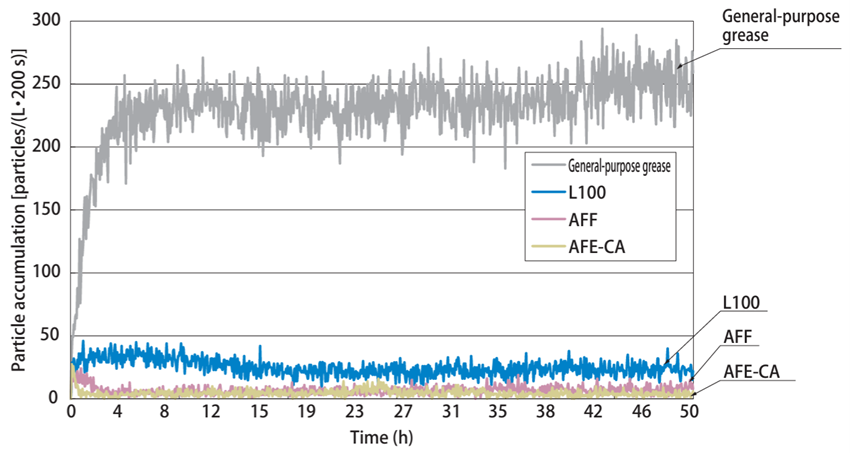
Responding to the Emerging Needs of AI Chip Development
In this article, we looked at the requirements of semiconductor manufacturing equipment and various products that fulfill them. As noted at the start, the demand for high-performance semiconductors is expected to rapidly increase in the near future. With big cloud service companies already starting to develop AI chips, there will be new demands placed on the linear motion guides used in the equipment that manufactures them. In response, THK will continue to provide technologies and products that offer high added value. Please contact THK for all your semiconductor equipment support needs.
Details about the Super-Low Waving Caged Ball LM Guide (Model: SPH) (THK website)
Details about the Miniature Full-Roller Type LM Guide Model HRG (THK website)
Product Journal article about super-low waving caged ball LM Guide models (THK website)
* This content is based on information that was released in Japanese on December 4, 2024.
Contact information
Please direct product inquiries to:
Application Engineering Department
2-12-10 Shibaura, Minato-ku, Tokyo 108-8506, Japan
Phone: +81-3-5730-3865 Fax: +81-3-5730-3918
Inquiry Form